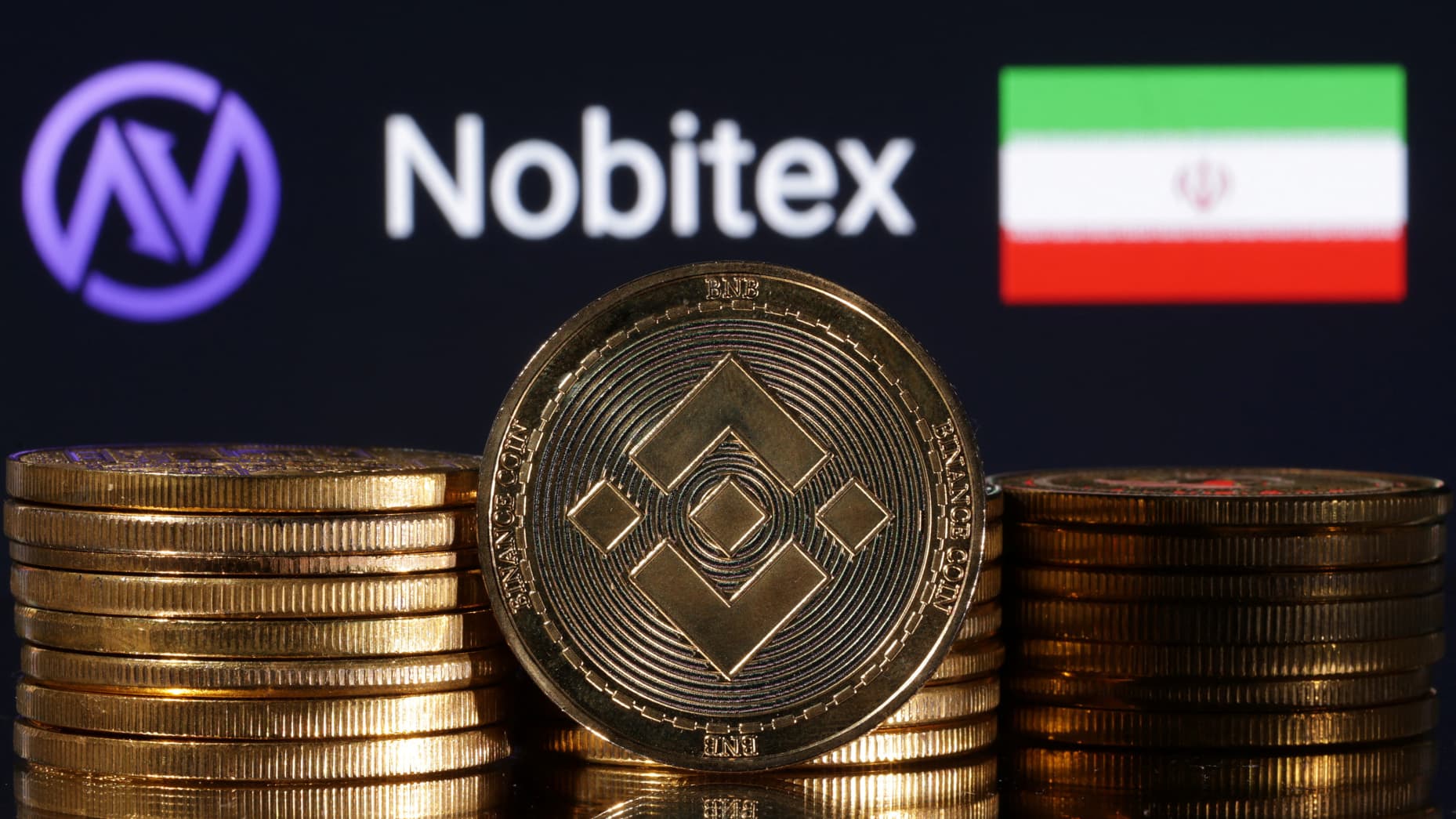A major cyber event targeting Iran’s largest cryptocurrency exchange, Nobitex, has raised questions about the evolving role of crypto in geopolitical conflict. The hack, which researchers attribute to a politically charged operation, involved movements of more than $90 million in digital assets to burner-style addresses bearing anti-government messages linked to Iran’s Islamic Revolutionary Guard Corps (IRGC). Analysts from Elliptic and Chainalysis describe the incident as a symbolic strike with potential implications for how crypto infrastructure can become a battleground in regional and international politics. The incident also follows heightened tensions between Israel and Iran, underscoring how cyber and financial layers can intersect in times of crisis. The precise financial motive remains unclear, with analysts noting that the stolen funds appear to have been moved to wallets that the attackers likely cannot access, suggesting destruction rather than profit. The episode has sparked ongoing scrutiny of Nobitex’s links to IRGC-associated actors and its past ties to sanctioned groups, as researchers work to map flows within Iran’s crypto ecosystem and to refine compliance tooling in response to new threats.
The Nobitex breach: what happened and what was affected
The incident involves Nobitex, Iran’s largest cryptocurrency exchange, which experienced a breach resulting in the drainage of more than $90 million from its platform wallets. According to the researchers, the funds were moved into a set of addresses that carried anti-government messaging explicitly referencing the IRGC. The movement of assets into these burner-style wallets has led analysts to conclude that the attackers intended to render the funds inaccessible rather than to profit from the theft.
Blockchain analytics firms have provided a broad catalog of the assets affected in the breach. In particular, Chainalysis identified a diversified mix of digital assets transacted as part of the incident, including popular cryptocurrencies such as Bitcoin and Ethereum, along with other tokens like Dogecoin, Ripple (XRP), Solana, Tron, and TON. The variety of tokens involved underscores the broad exposure of Nobitex users to a spectrum of assets beyond the most widely traded coins, and it highlights how large platforms may hold a wide asset mix that, if compromised, can complicate post-incident recovery and tracing efforts.
In addition to the financial movement, the attackers’ actions included messaging that explicitly tied the breach to political aims. The anti-government content associated with the burner wallets points toward a calculated effort to deliver a political signal as part of the theft. Elliptic reported that Nobitex was offline at the time they published their analysis, which limited initial investigative visibility and user access until the platform could resume operations. The offline status also means that real-time containment measures faced additional hurdles during the immediate aftermath of the incident.
In the wake of the initial breach, reports emerged of a separate cyberattack targeting another Iranian financial institution, Iran’s Bank Sepah, claimed by the same actor group. This second incident signals a broader campaign against Iranian financial infrastructure, with the attackers pursuing disruptive or symbolic effects rather than focusing solely on direct financial gain. The broader pattern of attacks in this period aligns with the heightened regional tensions and ongoing cyber operations observed across the region.
Attribution: who claimed responsibility and how it is framed
A pro-Israel hacking collective known as Gonjeshke Darande, translated as “Predatory Sparrow,” claimed responsibility for the Nobitex breach and asserted that it would release the exchange’s source code. The group’s claim, coupled with its rhetoric about disclosing the exchange’s codebase, positioned the attack within a broader narrative of political cyber operations intended to send a message to Iranian authorities. Elliptic noted that the exchange was offline at the time of the group’s post, which added a layer of operational complexity to the attribution process while the claim was being evaluated by researchers.
Predatory Sparrow’s claim also intersected with a separate cyberattack on Bank Sepah, another Iranian state-owned financial institution, which the group said it had attacked during the same week. The apparent parallel timing between opportunistic financial disruption and politically motivated messaging amplified concerns about a coordinated campaign targeting Iran’s financial sector during a period of high geopolitical volatility.
Analysts emphasize that, while the group has claimed involvement, the precise ownership and scope of the operation remain under review. The attribution in such cases typically relies on an amalgam of open-source signals, blockchain traces, and behavioral patterns observed on the network. The claim by Predatory Sparrow is a significant data point, but it requires corroboration from multiple sources before a definitive attribution is established in the traditional sense.
The technical signal: burner wallets and the meaning of non-financial theft
An important technical detail cited by Elliptic and Chainalysis is that the assets linked to Nobitex were transferred to burner wallets—cryptographic addresses believed to be controlled by the attackers with limited or no access to the private keys. This pattern is commonly interpreted by researchers as indicating that the funds were intended to be inaccessible or destroyed rather than immediately monetized through subsequent liquidity or sale. In other words, the financial loss might be a byproduct of a strategic political act rather than a straightforward robbery aimed at profit.
Andrew Fierman, who leads national security intelligence research at Chainalysis, described the motive as one that goes beyond financial gain. He stressed that the use of burner wallets is a deliberate design to prevent exfiltration of the stolen assets, signaling a symbolic objective behind the operation. Fierman’s assessment reflects a broader trend in which sophisticated actors use crypto infrastructure as a vehicle for geopolitical signaling. This perspective reinforces the idea that cyber-enabled financial actions are increasingly woven into broader strategic campaigns that seek to influence state behavior rather than simply accrue wealth.
From a security and policy standpoint, the use of burner wallets in a high-profile breach raises questions about the resilience of crypto platforms and their oversight regimes. If attackers can move funds into inaccessible addresses and publicly signal a political stance, exchanges face amplified governance and compliance challenges, including increased scrutiny from regulators, tighter internal controls, and the need for faster cross-border intelligence sharing. The incident thus elevates the profile of crypto infrastructure as a frontier in national security considerations, especially when it intersects with regional conflicts and non-state actors with political agendas.
Iran-Israel tensions and the geopolitical backdrop
The Nobitex breach occurred within a broader geopolitical context characterized by heightened tensions between Israel and Iran. Reports indicate ongoing cross-border hostilities, including missile exchanges, as part of a conflict dynamic that has long featured asymmetrical warfare, including cyber operations. In statements surrounding the incident, Iran’s leadership and senior officials engaged in rhetoric that underscores the fragility of regional security and the potential for cyber actions to become integrated with conventional military and political strategies.
On a public stage, Iran’s leadership, including Ayatollah Ali Khamenei, issued condemnations and warnings that reflected the seriousness with which certain adversaries view the region’s security balance. In parallel, U.S. policy responses and international sanctions dynamics continue to shape the strategic calculus for Tehran and its adversaries. The convergence of cyber activity and geopolitical signaling during this period illustrates how digital assets and cybersecurity incidents are becoming embedded in broader statecraft and geopolitical risk management.
Analysts argue that the motive behind the Nobitex incident is not merely criminal in nature but is indicative of a larger strategic play: to demonstrate vulnerability in a regional economy, to assert political messaging across digital channels, and to test the resilience of crypto-infrastructure in the face of state-level and non-state actor aggression. The combination of a high-profile hack, anti-government messaging, and a potentially destabilizing impact on Iran’s financial infrastructure carries significant implications for how policymakers, exchanges, and regulators think about cyber risk in the region.
The evidence and the broader picture: IRGC links and historical patterns
Elliptic’s examination of Nobitex’s activity has linked the exchange to the IRGC, a powerful arm of Iran’s military that many Western governments designate as a terrorist organization. The research points to historical ties between Nobitex and IRGC-linked ransomware operators and individuals who are closely connected to Ayatollah Khamenei’s inner circle. The researchers also note that blockchain data reveals activity between Nobitex and wallets associated with listed regional actors, including Hamas, Palestinian Islamic Jihad, and the Houthis. This pattern of connections, while not proving direct operational collaboration in the current breach, contributes to a broader understanding of the exchange’s ecosystem and the potential for sanctioned or extremist-aligned actors to interact with crypto infrastructures in ways that raise compliance concerns.
Elliptic further stated that it would continue monitoring virtual asset flows tied to Iranian entities and has updated its compliance tools to reflect emerging threats in the region’s evolving crypto landscape. The updates aim to help financial institutions, exchanges, and regulators better identify and mitigate risk stemming from sanctioned networks and politically motivated campaigns. The ongoing monitoring underscores the importance of proactive risk management in regions where geopolitical strife intersects with rapidly developing digital asset ecosystems.
From a historical perspective, prior investigations have connected Nobitex to sanctioned IRGC-linked ransomware operatives and individuals with close ties to the country’s leadership. These connections are not isolated to a single incident but form part of a broader pattern that researchers say is relevant to understanding the risk profile of Iranian crypto infrastructure. The existence of such ties informs ongoing debates about sanctions enforcement, due diligence requirements for exchanges operating in or with Iranian entities, and the need for continuous updates to compliance and monitoring frameworks as new threats emerge.
Implications for the crypto ecosystem and regulatory response
The Nobitex breach has several notable implications for the crypto ecosystem, particularly in regions with heightened geopolitical risk. First, the incident demonstrates how political motivations can be interwoven with cyber and crypto operations, signaling a shift in the perceived role of digital assets in modern conflict. Even if the immediate financial motive remains unclear or limited, the strategic messaging and symbolic nature of the attack can influence public perception, regulatory attitudes, and the behavior of exchanges operating in sensitive environments.
Second, the event highlights the importance of robust counterparty risk management, incident response, and operational resilience for crypto platforms. The fact that Nobitex was offline during and after the breach underscores the need for rapid containment measures, transparent communication with users, and effective mechanisms for preserving user assets and data integrity during crises. Regulators and industry groups may respond by pushing for stronger security standards, better cross-border information sharing, and more explicit guidance on how exchanges should handle politically charged cyber incidents.
Third, the case reinforces the role of independent blockchain analytics firms in shaping the public understanding of cyber events and in informing regulatory and compliance decisions. The insights provided by Elliptic and Chainalysis—on asset types involved, the use of burner wallets, and the geopolitical signals embedded in the attack—help build a more nuanced picture of risk across the crypto landscape. As the industry evolves, the collaboration between exchanges, analytics firms, and policymakers will be critical to maintaining trust, ensuring due diligence, and promoting responsible innovation.
Fourth, the broader geopolitical dimension—especially in tense regions—implies that even smaller or regional crypto platforms can become strategic targets. The Nobitex incident suggests that cyber operations may aim to disrupt financial infrastructure beyond maximizing immediate profits, including sending political signals that reverberate across regional markets. This realization could influence how exchanges design resilience strategies, engage with sanctions regimes, and implement compliance tools that can detect and mitigate flows tied to politically sensitive actors.
Fifth, the ongoing monitoring by research firms to track flows connected to Iranian entities informs both the private sector and regulators about evolving risk patterns. It also reinforces the need for continuous investment in threat intelligence, risk scoring, and adaptive tooling that can identify non-obvious patterns—such as activity that links to groups with broad geopolitical agendas, including extremist or state-aligned actors. The dynamic nature of such threats will likely sustain the emphasis on proactive risk management, dynamic screening, and enhanced international cooperation in the crypto space.
Past investigations and the broader historical context
The Nobitex episode is situated within a broader historical context in which the exchange has faced scrutiny for its associations with IRGC-linked actors. Investigations and intelligence assessments have previously connected Nobitex to ransomware operators and individuals closely tied to Iran’s leadership. These past connections, while not proof of direct involvement in every incident, contribute to a complex risk profile for Nobitex and similar platforms operating in or with Iranian markets.
Blockchain data indicating activity between Nobitex and wallets linked to Hamas, Palestinian Islamic Jihad, and the Houthis adds another layer to the narrative. While it does not confirm a direct operational alliance in the current breach, it signals that Nobitex operates within a network of wallets and actors with recognized political and militant affiliations. For regulators and risk managers, such patterns underscore the necessity of considering both direct sanctions compliance and broader network risk when evaluating exchanges that operate in geopolitically sensitive regions.
Elliptic’s ongoing monitoring and updates to compliance tools reflect a forward-looking approach, acknowledging that threats evolve as geopolitical situations shift. The goal is to maintain visibility into crypto flows that may intersect with sanctioned entities or groups engaged in conflict, thereby supporting more effective risk management and regulatory oversight.
The takeaway for policymakers, exchanges, and users
- Geopolitics increasingly intersects with crypto security. The Nobitex case illustrates how political messaging, not just financial gain, can motivate attackers and influence the behavior of digital asset platforms.
- Burner wallets as a strategic signal. The use of inaccessible addresses signals a shift in attacker objectives toward symbolic impact and disruption, raising questions about how exchanges should respond to similar patterns in real time.
- Regulatory and compliance vigilance. The case reinforces the need for robust sanctions screening, real-time monitoring, and cross-border information sharing to mitigate risk associated with sanctioned or extremist-linked actors.
- Operational resilience matters. For users, the incident underscores the importance of platform security, incident response readiness, and clear communication from exchanges during crises.
- Continuous threat intelligence is essential. Ongoing research into flows connected to Iran and allied groups helps quantify risk and shape proactive defensive measures within the crypto ecosystem.
Conclusion
The Nobitex breach represents more than a single financial incident; it signals a broader shift in how cyber operations, cryptocurrency infrastructure, and geopolitical conflict can converge. The evidence points to a politically motivated action, with burner-wallet movements and anti-government messaging that align with broader regional tensions, particularly between Israel and Iran. Although the exact financial motive remains uncertain, analysts emphasize that the incident is as much about signaling and political impact as it is about theft. The involvement of Predatory Sparrow, the purported links to IRGC, and the observed activity tying Nobitex to sanctioned networks collectively highlight the growing importance of threat intelligence, compliance tooling, and resilience planning for crypto platforms navigating a complex geopolitical landscape. As authorities, researchers, and industry players continue to map flows, assess risk, and update protective measures, the Nobitex episode will likely influence how exchanges approach security, sanctions compliance, and strategic risk management in a world where digital assets increasingly operate at the intersection of finance and geopolitics.


